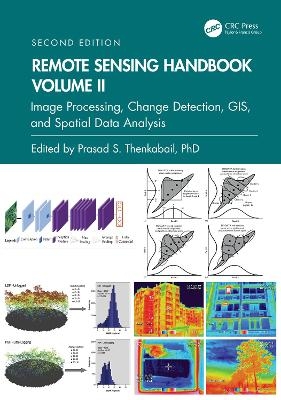
Remote Sensing Handbook, Volume II
CRC Press (Verlag)
978-1-032-89097-5 (ISBN)
- Lieferbar (Termin unbekannt)
- Versandkostenfrei
- Auch auf Rechnung
- Artikel merken
Volume II of the Six Volume Remote Sensing Handbook, Second Edition, is focused on digital image processing including image classification methods in land cover and land use. It discusses object-based segmentation and pixel-based image processing algorithms, change detection techniques, and image classification for a wide array of applications including land use/land cover, croplands, urban studies, processing hyperspectral remote sensing data, thermal imagery, light detection and ranging (LiDAR), geoprocessing workflows, frontiers of GIScience, and future pathways. This thoroughly revised and updated volume draws on the expertise of a diverse array of leading international authorities in remote sensing and provides an essential resource for researchers at all levels interested in using remote sensing. It integrates discussions of remote sensing principles, data, methods, development, applications, and scientific and social context.
Features
Provides the most up-to-date comprehensive coverage of digital image processing.
Highlights object-based image analysis (OBIA) and pixel-based classification methods and techniques of digital image processing.
Demonstrates practical examples of image processing for a myriad of applications such as land use/land cover, croplands, and urban.
Establishes image processing using different types of remote sensing data that includes multispectral, radar, LiDAR, thermal, and hyperspectral.
Highlights change detection, geoprocessing, and GIScience.
This volume is an excellent resource for the entire remote sensing and GIS community. Academics, researchers, undergraduate and graduate students, as well as practitioners, decision makers, and policymakers, will benefit from the expertise of the professionals featured in this book, and their extensive knowledge of new and emerging trends.
Dr. Prasad S. Thenkabail, Senior Scientist (ST), United States Geological Survey (USGS), is a world-recognized expert in remote sensing science with major contributions in the field for nearly 40 years. He has made the list of the world’s top 1% of scientists across 22 scientific fields and 176 sub-fields. Dr. Thenkabail has conducted pioneering research in hyperspectral remote sensing of vegetation, global croplands, and their water use for food security. He obtained his PhD from the Ohio State University in 1992 and has 168 peer-reviewed publications including 15 books, including this six-volume set, and over 15 major data releases such as the Landsat-derived global cropland extent product @ 30m and Landsat-derived rainfed and irrigated cropland area product @ 30 m (LGRIP30). He was recognized as a Fellow of the American Society of Photogrammetry and Remote Sensing (ASPRS) in 2023. His scientific papers have won several awards for demonstrating world-class, highest-quality research. He was a Landsat Science Team Member (2007-2011).
Part I: Image Processing Methods and Approaches. 1. Digital Image Processing: A Review of the Fundamental Methods and Techniques. 2. Image Classification Methods in Land Cover and Land Use and Cropland Studies. 3. Urban Image Classification: Per-pixel Classifiers, Sub-pixel Analysis, Object-based Image Analysis, and Geospatial Methods. 4. Hyperspectral Image Processing: Methods and Approaches. 5. Collaborative Representation for Hyperspectral Image Classification and Detection. 6. Thermal Infrared Remote Sensing: Principles and Theoretical Background. 7. Remote Sensing Image Segmentation: Methods, Approaches, and Advances. 8. Object Based Image Analysis: Evolution, History, State-of-the-Art and Future Vision. 9. Geospatial Data Integration in OBIA- implications of Accuracy and Validity. 10. Image Segmentation Algorithms for Land Categorization. 11. LiDAR Data Processing and Applications. Part II: Change Detection. 12. Forest Clear-Cutting Detection in Subtropical Regions with Time Series Remotely Sensed Data. Part III: Integrating Geographic Information Systems (GIS) and Remote Sensing in Spatial Modeling Framework for Decision Support. 13. Geoprocessing, Workflows, and Provenance. 14. Toward Democratization of Geographic Information: GIS, Remote Sensing, and GNSS Applications in Everyday Life. 15. Frontiers of GIScience: Evolution, State-of-Art, and Future Pathways. 16. Object-Based Regionalization for Policy-Oriented Partitioning of Space. Part IV: Summary and Synthesis of Volume II. 17. Remote Sensing Handbook, Volume II: Image Processing, Change Detection, GIS and Spatial Data Analysis.
| Erscheinungsdatum | 06.11.2024 |
|---|---|
| Reihe/Serie | Remote Sensing Handbook |
| Zusatzinfo | 44 Tables, black and white; 114 Line drawings, color; 29 Line drawings, black and white; 67 Halftones, color; 6 Halftones, black and white; 181 Illustrations, color; 35 Illustrations, black and white |
| Verlagsort | London |
| Sprache | englisch |
| Maße | 178 x 254 mm |
| Gewicht | 1100 g |
| Themenwelt | Informatik ► Grafik / Design ► Digitale Bildverarbeitung |
| Naturwissenschaften ► Geowissenschaften ► Geografie / Kartografie | |
| Naturwissenschaften ► Geowissenschaften ► Geologie | |
| Technik ► Umwelttechnik / Biotechnologie | |
| Weitere Fachgebiete ► Land- / Forstwirtschaft / Fischerei | |
| ISBN-10 | 1-032-89097-5 / 1032890975 |
| ISBN-13 | 978-1-032-89097-5 / 9781032890975 |
| Zustand | Neuware |
| Informationen gemäß Produktsicherheitsverordnung (GPSR) | |
| Haben Sie eine Frage zum Produkt? |
aus dem Bereich


